Readings Newsletter
Become a Readings Member to make your shopping experience even easier.
Sign in or sign up for free!
You’re not far away from qualifying for FREE standard shipping within Australia
You’ve qualified for FREE standard shipping within Australia
The cart is loading…






This title is printed to order. This book may have been self-published. If so, we cannot guarantee the quality of the content. In the main most books will have gone through the editing process however some may not. We therefore suggest that you be aware of this before ordering this book. If in doubt check either the author or publisher’s details as we are unable to accept any returns unless they are faulty. Please contact us if you have any questions.
The normal business of physicists may be schematically thought of as predic ting the motions of particles on the basis of known forces, or the propagation of radiation on the basis of a known constitution of matter. The inverse problem is to conclude what the forces or constitutions are on the basis of the observed motion. A large part of our sensory contact with the world around us depends on an intuitive solution of such an inverse problem: We infer the shape, size, and surface texture of external objects from their scattering and absorption of light as detected by our eyes. When we use scattering experiments to learn the size or shape of particles, or the forces they exert upon each other, the nature of the problem is similar, if more refined. The kinematics, the equations of motion, are usually assumed to be known. It is the forces that are sought, and how they vary from point to point. As with so many other physical ideas, the first one we know of to have touched upon the kind of inverse problem discussed in this book was Lord Rayleigh (1877). In the course of describing the vibrations of strings of variable density he briefly discusses the possibility of inferring the density distribution from the frequencies of vibration. This passage may be regarded as a precursor of the mathematical study of the inverse spectral problem some seventy years later.
$9.00 standard shipping within Australia
FREE standard shipping within Australia for orders over $100.00
Express & International shipping calculated at checkout
Stock availability can be subject to change without notice. We recommend calling the shop or contacting our online team to check availability of low stock items. Please see our Shopping Online page for more details.
This title is printed to order. This book may have been self-published. If so, we cannot guarantee the quality of the content. In the main most books will have gone through the editing process however some may not. We therefore suggest that you be aware of this before ordering this book. If in doubt check either the author or publisher’s details as we are unable to accept any returns unless they are faulty. Please contact us if you have any questions.
The normal business of physicists may be schematically thought of as predic ting the motions of particles on the basis of known forces, or the propagation of radiation on the basis of a known constitution of matter. The inverse problem is to conclude what the forces or constitutions are on the basis of the observed motion. A large part of our sensory contact with the world around us depends on an intuitive solution of such an inverse problem: We infer the shape, size, and surface texture of external objects from their scattering and absorption of light as detected by our eyes. When we use scattering experiments to learn the size or shape of particles, or the forces they exert upon each other, the nature of the problem is similar, if more refined. The kinematics, the equations of motion, are usually assumed to be known. It is the forces that are sought, and how they vary from point to point. As with so many other physical ideas, the first one we know of to have touched upon the kind of inverse problem discussed in this book was Lord Rayleigh (1877). In the course of describing the vibrations of strings of variable density he briefly discusses the possibility of inferring the density distribution from the frequencies of vibration. This passage may be regarded as a precursor of the mathematical study of the inverse spectral problem some seventy years later.